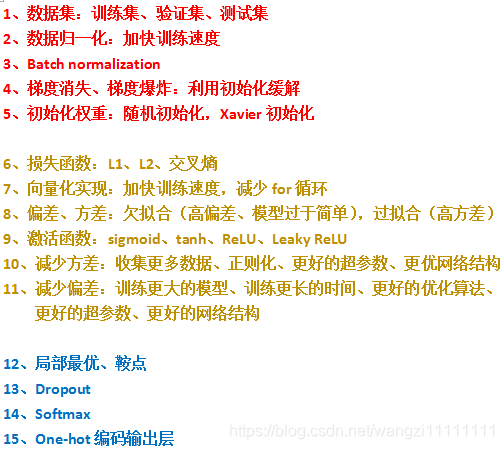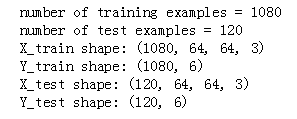文章目录
- 目录
- 1.神经网络知识概览
- 1.1深度学习顶会
- 1.2相关比赛
- 1.3神经网络知识概览
- 1.4神经网络编程一般实现过程
- 2.简单神经网络ANN
- 2.1 数据集:
- 2.2 网络结构:
- 2.3 代码实现
- 2.3.1 读取数据,并做处理
- 2.3.2 构建网络结构
- 2.3.3 训练网络
目录
1.神经网络知识概览
1.1深度学习顶会
- CVPR : IEEE Conference on Computer Vision and Pattern Recognition
- CVPR是计算机视觉与模式识别顶会
- ICCV:IEEE International Conference on Computer Vision
- ICCV论文录用率非常低,是三大会议中公认级别最高的
- ECCV:European Conference on Computer Vision
1.2相关比赛
1.ImageNet
- ImageNet 数据集最初由斯坦福大学李飞飞等人在 CVPR 2009 的一篇论文中推出


2.webvision

1.3神经网络知识概览


1.4神经网络编程一般实现过程
1.数据预处理
2.定义神经网络结构
3.初始化网络模型中的参数
4.开始训练模型
loop(number_iterations):forward propagationcompute costbackward propagationupdate parameters
5.对新的数据进行预测
2.简单神经网络ANN
2.1 数据集:
- 训练集 + 测试集
- 训练集:训练集 + 评估集


- 数据信息:

2.2 网络结构:
- 网络结构 linear -> relu -> linear -> relu -> linear -> softmax
- 网络结构12288 -> 25 -> 12 -> 6
- 迭代次数1000,学习率0.0001,minibatch_size=32,优化算法Adam
- 将RGB图片转换为向量(损失空间结构信息)
- 出现过拟合,应该使用正则化(L2、Dropout、早停)
2.3 代码实现
2.3.1 读取数据,并做处理
import math
import h5py
import numpy as np
import tensorflow as tf
import matplotlib.pyplot as plt
import scipy
from PIL import Image
from scipy import ndimage
from tensorflow.python.framework import ops
from improv_utils import *%matplotlib inline
np.random.seed(1)# 下载数据
X_train_orig, Y_train_orig, X_test_orig, Y_test_orig, classes = load_dataset()# 显示图片
index = 2
plt.imshow(X_train_orig[index])
plt.show()
print("y = " + str(np.squeeze(Y_train_orig[:, index])))# 将数据平铺,归一化,标签one-hot
X_train_flatten = X_train_orig.reshape(X_train_orig.shape[0], -1).T
X_test_flatten = X_test_orig.reshape(X_test_orig.shape[0], -1).TX_train = X_train_flatten/255.
X_test = X_test_flatten/255.Y_train = convert_to_one_hot(Y_train_orig, 6)
Y_test = convert_to_one_hot(Y_test_orig, 6)print ("number of training examples = " + str(X_train.shape[1]))
print ("number of test examples = " + str(X_test.shape[1]))
print ("X_train shape: " + str(X_train.shape))
print ("Y_train shape: " + str(Y_train.shape))
print ("X_test shape: " + str(X_test.shape))
print ("Y_test shape: " + str(Y_test.shape))
y = 2
number of training examples = 1080
number of test examples = 120
X_train shape: (12288, 1080)
Y_train shape: (6, 1080)
X_test shape: (12288, 120)
Y_test shape: (6, 120)
2.3.2 构建网络结构
# 1-1、创建占位符
def create_placeholders(n_x, n_y):"""Creates the placeholders for the tensorflow session.Arguments:n_x -- scalar, size of an image vector (num_px * num_px = 64 * 64 * 3 = 12288)n_y -- scalar, number of classes (from 0 to 5, so -> 6)Returns:X -- placeholder for the data input, of shape [n_x, None] and dtype "float"Y -- placeholder for the input labels, of shape [n_y, None] and dtype "float"Tips:- You will use None because it let's us be flexible on the number of examples you will for the placeholders.In fact, the number of examples during test/train is different."""X = tf.placeholder(tf.float32, shape = [n_x, None])Y = tf.placeholder(tf.float32, shape = [n_y, None])return X, Y# 1-2、初始化参数
def initialize_parameters():"""Initializes parameters to build a neural network with tensorflow. The shapes are:W1 : [25, 12288]b1 : [25, 1]W2 : [12, 25]b2 : [12, 1]W3 : [6, 12]b3 : [6, 1]Returns:parameters -- a dictionary of tensors containing W1, b1, W2, b2, W3, b3"""tf.set_random_seed(1) # so that your "random" numbers match oursW1 = tf.get_variable("W1", [25,12288], initializer = tf.contrib.layers.xavier_initializer(seed = 1))b1 = tf.get_variable("b1", [25,1], initializer = tf.zeros_initializer())W2 = tf.get_variable("W2", [12,25], initializer = tf.contrib.layers.xavier_initializer(seed = 1))b2 = tf.get_variable("b2", [12,1], initializer = tf.zeros_initializer())W3 = tf.get_variable("W3", [6,12], initializer = tf.contrib.layers.xavier_initializer(seed = 1))b3 = tf.get_variable("b3", [6,1], initializer = tf.zeros_initializer())parameters = {"W1": W1,"b1": b1,"W2": W2,"b2": b2,"W3": W3,"b3": b3}return parameters# 1-3、TensorFlow中的前向传播
# tf中前向传播停止在z3,是因为tf中最后的线性层输出是被作为输入计算loss,不需要a3
def forward_propagation(X, parameters):"""Implements the forward propagation for the model: LINEAR -> RELU -> LINEAR -> RELU -> LINEAR -> SOFTMAXArguments:X -- input dataset placeholder, of shape (input size, number of examples)parameters -- python dictionary containing your parameters "W1", "b1", "W2", "b2", "W3", "b3"the shapes are given in initialize_parametersReturns:Z3 -- the output of the last LINEAR unit"""W1 = parameters['W1']b1 = parameters['b1']W2 = parameters['W2']b2 = parameters['b2']W3 = parameters['W3']b3 = parameters['b3']Z1 = tf.add(tf.matmul(W1, X), b1) # Z1 = np.dot(W1, X) + b1A1 = tf.nn.relu(Z1) # A1 = relu(Z1)Z2 = tf.add(tf.matmul(W2, A1), b2) # Z2 = np.dot(W2, a1) + b2A2 = tf.nn.relu(Z2) # A2 = relu(Z2)Z3 = tf.add(tf.matmul(W3, A2), b3) # Z3 = np.dot(W3,Z2) + b3return Z3# 1-4、计算成本函数
def compute_cost(Z3, Y):"""Computes the costArguments:Z3 -- output of forward propagation (output of the last LINEAR unit), of shape (6, number of examples)Y -- "true" labels vector placeholder, same shape as Z3Returns:cost - Tensor of the cost function"""# to fit the tensorflow requirement for tf.nn.softmax_cross_entropy_with_logits(...,...)logits = tf.transpose(Z3)labels = tf.transpose(Y)# 函数输入:shape =(样本数,类数)# tf.reduce_mean()cost = tf.reduce_mean(tf.nn.softmax_cross_entropy_with_logits(logits = logits, labels = labels))return cost
def predict(X, parameters):W1 = tf.convert_to_tensor(parameters["W1"])b1 = tf.convert_to_tensor(parameters["b1"])W2 = tf.convert_to_tensor(parameters["W2"])b2 = tf.convert_to_tensor(parameters["b2"])W3 = tf.convert_to_tensor(parameters["W3"])b3 = tf.convert_to_tensor(parameters["b3"])params = {"W1": W1,"b1": b1,"W2": W2,"b2": b2,"W3": W3,"b3": b3}x = tf.placeholder("float", [12288, 1])z3 = forward_propagation(x, params)p = tf.argmax(z3)with tf.Session() as sess:prediction = sess.run(p, feed_dict = {x: X})return prediction2.3.3 训练网络
my_image = "my_image.jpg"
fname = "images/" + my_imageimage = np.array(ndimage.imread(fname, flatten=False))
my_image = scipy.misc.imresize(image, size=(64,64)).reshape((1, 64*64*3)).T
parameters = model(X_train, Y_train, X_test, Y_test)plt.imshow(image)
plt.show()my_image_prediction = predict(my_image, parameters)
print("Your algorithm predicts: y = " + str(np.squeeze(my_image_prediction)))
-if语句,断言assert)
-- CNN学习)

-Modeling the World from Internet Photo Collections)
-- 典型CNN结构(LeNet5 ,AlexNet))

-while语句+赋值运算符号+转义字符)

)
-Generative Adversarial Net-代码实现资料)
--典型CNN结构(VGG13,16,19))

-内置/自己设计的损失函数使用)

-- Network in Network(NIN))
-tensor常用操作)
)
-- 经典CNN网络结构(Inception (v1-v4)))
-函数,lambda语句)
-- Residual Network (ResNet))